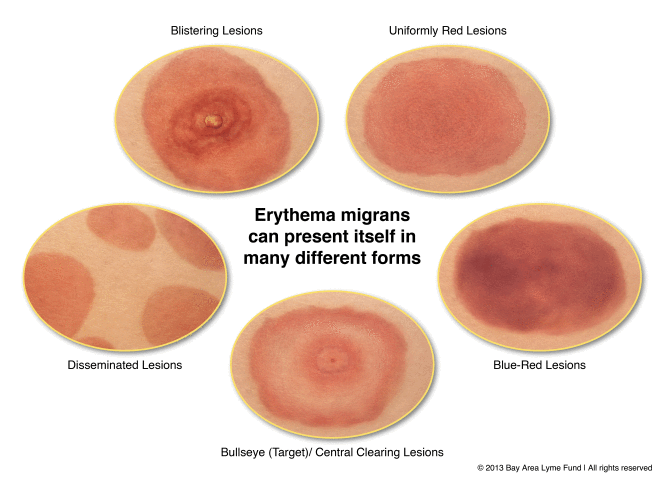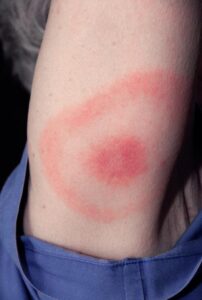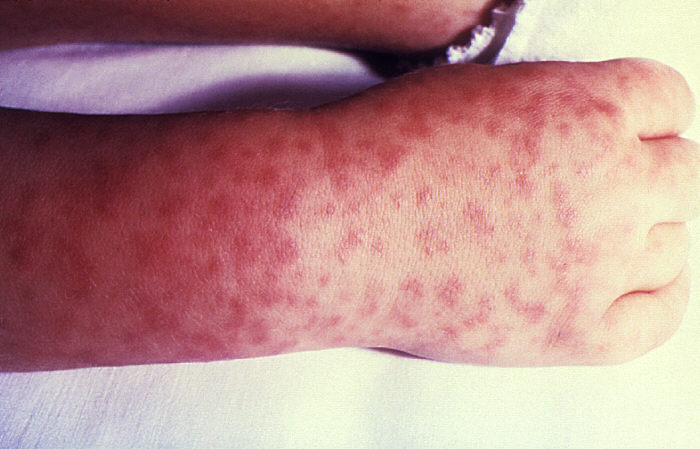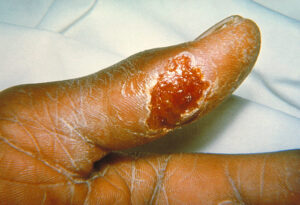Getting—and noticing—a rash from a tick bite can be a blessing in disguise.
Our daughter Michaela had the classic bull’s-eye rash. Without it, we wouldn’t have realized she had Lyme disease so quickly. Early symptoms mirror the flu. As a result, the nurse practitioner originally thought Michaela just had a simple virus.
But what if you don’t recognize the different forms of the Lyme disease rash? And how can you distinguish the Lyme disease rash from other kinds of tick bite rashes? That’s what we’re going to discover today.
Erythema Migrans: The Lyme Disease Rash
Estimates on the number of Lyme patients who notice a rash range widely. Some studies put the number as high as eighty percent and others as low as twenty-seven percent. Regardless, the rash usually appears three to thirty days after the tick bite.
According to the Maryland Department of Health (MDH), “Most clinicians recognize the classic target lesion or bull’s-eye rash. However, most are not aware that the majority of Lyme disease skin lesions are uniformly red or reddish-blue.”
In other words, most Lyme disease rashes do not resemble a bull’s-eye.

Uniformly-Red Lesions
In fact, most Lyme rashes are uniformly red. But, according to MDH, “They are distinguished from other skin rashes by their round or oval shape and sharply demarcated borders.”
Blue-Red or Blue-Purple Lesions
The second most common Lyme disease rash—bluish-red and bluish-purple ones—are sometimes mistaken for bruises.

Central-Clearing Lesions: The Classic Bull’s Eye Rash
Though the target lesion is the most recognized, only twenty percent of Lyme rashes mimic bull’s eyes.
Blistering Lesions
Rarely, a Lyme rash will blister in the middle. These blistering lesions are often mistaken for spider bites.
Disseminated Lesions
Untreated, the Lyme may spread to other parts of your body, resulting in many lesions.
Other Kinds of Tick Bite Rashes
Ehrlichiosis
About thirty percent of patients with ehrlichiosis will get pinpoint dots or red splotches.
Rocky Mountain Spotted Fever (RMSF)
Early symptoms of RMSF include fever, headache, nausea, vomiting, muscle pain, and stomach pain. Two to six days after the fever starts, the rash usually appears.
Sometimes it’s a splotchy, spotted, red-to-purple rash. Other times, it’s small, pink spots on the palms, soles, wrists, forearms, or ankles.

Unfortunately, according to the CDC, “About ten percent of people . . . never develop a rash.”
Southern Tick-Associated Rash Illness (STARI)
As with Lyme disease, the STARI rash is a red, bull’s-eye lesion that expands over time.

Tularemia
Finally, with tularemia, the CDC says, “a skin ulcer appears at the site where the organism entered the body. The ulcer is accompanied by swelling of regional lymph glands, usually in the armpit or groin.”
But what if you don’t notice a rash or an ulcer? What early symptoms of Lyme or other tick-borne diseases should you be able to recognize? Click here to find out!




Pingback: Tick Bite Symptoms: Our Earliest Warning - Never Alone
I had a friend growing up that had rmsf and he was REALLY sick. Amazing how rashes can differ and being a person who bruises easily, I probably wouldn’t pay any attention to something that looks like that. I will, however try to remember all of your information for the future and pray that you and anyone in your family who has been affected will be healed.
Thank you so much, Lisa!!! 🙂 And, yes, Rocky Mountain Spotted Fever can be very dangerous—even deadly.
Pingback: Lyme Disease Awareness: Lyme's Three Stages - Never Alone
Pingback: Primary Care: How to Advocate for Yourself - Never Alone
Pingback: The Lyme Ab Screen: Four Reasons It Fails - Never Alone
Pingback: Catching Lyme Disease Early before It Spreads - Never Alone
Pingback: After a Tick Bite, Watch for These Symptoms - Never Alone